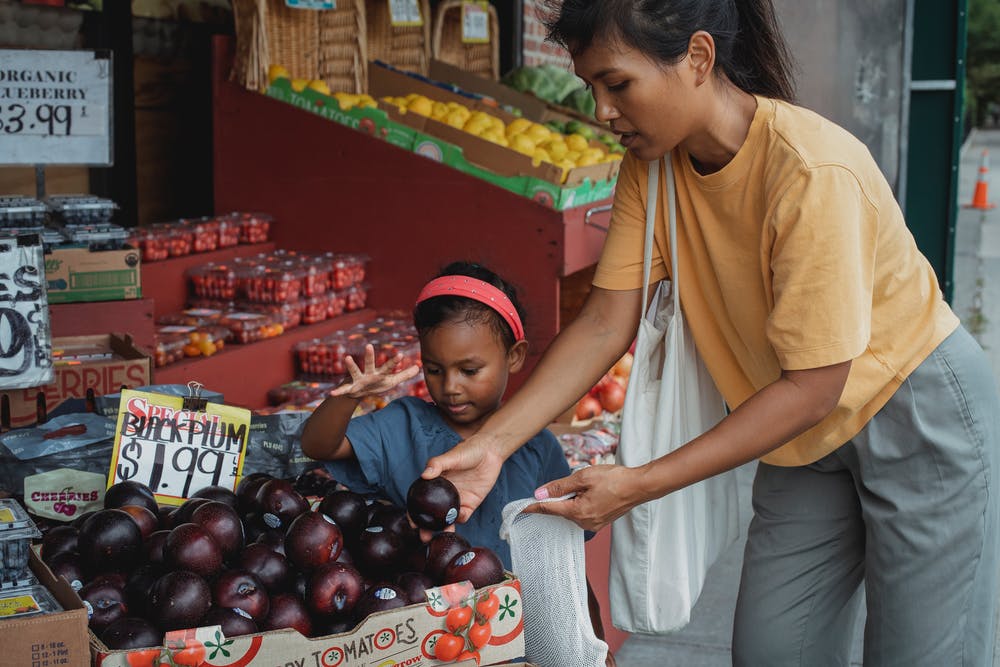Just because we’re homeschool mamas doesn’t mean we have a proclivity to be homemakers.
But a little organization, planning, and practice go a long way in making that aspect of the homeschool life a whole lot smoother.
So how to grocery shop & cook for your homeschool family? Here are tips I’ve gleaned over my twenty years of homemaking life.
So how to grocery shop & cook for your homeschool family?
1. Consider how much meat you purchase.
Meat is likely the most expensive part of your grocery budget. Include lentils, beans, and eggs, even tofu. I know, I didn’t grow up that way either. Assume that twice a week, you’re not eating meat (unless, of course, you’re already a vegetarian;). You’ll definitely get used to this, and appreciate the benefits of eating lighter.
2. Buy whatever you normally consume when it’s on sale at the grocery store.
Stock the pantry with things you regularly use. Chia seeds and pine nuts don’t need to be on hand. But pasta, rice, and potatoes do. (Unless you’re gluten-free, but you already knew that then.) Buy fish or meat on sale, and stick it in the freezer. If you’re routinely eating similar foods, you know you’re going to eat again, so plan for that.
3. Buy in season.
It was less expensive. Buy enough for the week. Don’t get fussy about having Brussels sprouts paired with roast or green beans with salmon. Use the vegetables you have on hand. (If you have a bag of precut carrots or snap peas, pull those out for alternative kid veggies when you’re serving the adults rapini).
4. Think in partitioned plate.
Half veggie, quarter meat, and quarter carbs. Simple.
5. Buy expensive ingredients sparingly.
Prepared foods are more expensive. Specialty ingredients like cans of roasted red peppers or European cheeses are more expensive. Organic oranges and produce with thick skins are expensive organic purchases.
6. Use the same grocery store.
Your mind knows where to find maple syrup in the main grocery store you use. Go to another store, and they’ve got it somewhere random. Every time you walk past the peanut butter section, that will be your reminder to grab it. (Also, teach the kids to find things for you, a treasure hunt for the younger kids.)

7. Cook more than you need.
If you’re cooking from scratch, make more than one meal. Freeze the rest. But label what you put in there so you don’t have random surprises like ‘chicken broth’ for lunch, instead of the butternut squash soup you thought you were defrosting. You’ll thank yourself later.
8. Teach the kids to cook.
No greater freedom than not having to cook all the time. Let the kids feed you. Try this when they’re younger when they’re certain cooking is just fun. If they’re old enough not to burn the house down, they are old enough to cook. If they’re not, then wait. When they begin to cook, walk away from the kitchen. “Your way” might be better, but natural learning reigns in the kitchen. It is a guarantee that if they put too much baking soda in their cupcakes, they will never do it again. When they start getting good at food preparation, tell them you’ll clean up if they make dinner. Win-win.
9. Recreate leftovers.
Leftovers are a mama’s best friend. Learn how to turn a basic beef roast into fajitas. Learn how to turn baked salmon into salmon cakes. Chicken to chicken pot pie. Pork chops to stir-fries. Learn to recreate.
10. Cook flexibly.
I know we were taught that a Caesar salad is a good complement to lasagne. That biscuits and gravy must go with grits. That roast chicken and tiny roasted potatoes pair well with a nice sauvignon blanc. But we have other stuff to do! Just feed the kids. Get a veggie to fill half that plate, a quarter plate of carbs, and a quarter plate of protein. Tada.
11. Learn to cook.
The more you learn to cook many things, the easier it is to improvise. Now add a glass of vino, turn on a YouTube cooking show, and have fun. This night, send the kids to watch television or screen out with the iPad.
12. Takeaway tips.
The first two years we lived in this rural community, we drove a half-hour to our extracurriculars. We ate out four times a week. This was expensive. Eating out regularly eats up monthly budgets.
So we learned a few simple recipes for takeaway food. Plastic food containers were designated for each of your traveling family members.
These are recipes that our family enjoys toting along in our extracurricular adventures: Chicken Caesar Wraps, Pizza (of course), Veggie Burgers, Pasta, Lentil Nuggets, and Quesadillas.
13. Build a list that works for your family.
- What will they actually eat?
- What can you easily eat without a mess in the car?
- What can you eat in between errands and activities?
14. Here are a few of our favourite easy-to-home-make takeaway meals:
My daughter, Madelyn, and I have been recording and creating cooking demonstrations, The Homeschool Kitchen, found on my YouTube channel if you’re looking for other inspired meal ideas:
- Veggie Burgers & Homemade Buns
- Creamy Cashew Pasta
- Fish Tacos
- Spicy Tofu Bowl
- Roast Chicken
- Bean Chili & Cornbread
- Black Bean Enchiladas
- Chicken Curry

Wellness Guide: Homeschool Help for Moms
Introducing Your Ultimate Wellness Guide, an ideal guidebook for homeschool moms seeking effective strategies to maintain physical, mental, and emotional wellbeing. This comprehensive guide offers practical tips, actionable steps, and easy-to-follow instructions to help you prioritize self-care, manage stress, and enhance your overall homeschool experience. Get your copy now and take the first step towards a healthier and happier homeschool mom life!
People also ask:
- How to Create a Homeschool Weekly Menu Plan: Start with Fish Monday
- How to Create a Homeschool Weekly Menu Plan: Chicken Tuesday
- How to Create a Homeschool Menu Plan: Vegan Wednesday
- How to Create a Homeschool Menu Plan: Leftover Thursday
- How to Create a Homeschool Menu Plan: Pizza Friday
- How to Create a Homeschool Diet


